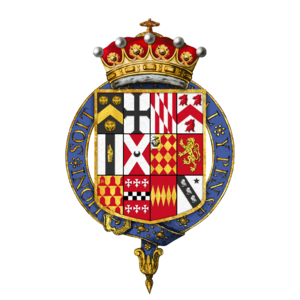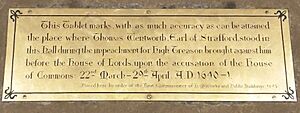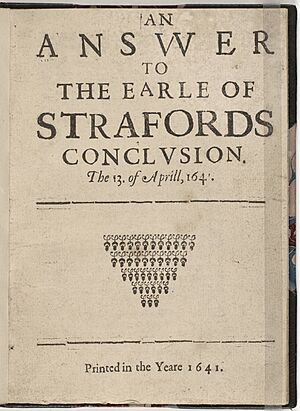Thomas Wentworth, 1st Earl of Strafford facts for kids
Quick facts for kids
The Earl of Strafford
|
|
|---|---|
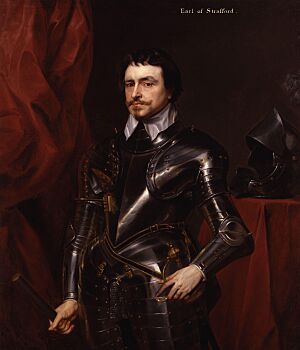
Portrait by Anthony van Dyck, 1639
|
|
| Lord Deputy of Ireland | |
| In office 1632–1640 |
|
| Vice-admiral of Munster | |
| In office 1634–1640 |
|
| Custos Rotulorum of the West Riding of Yorkshire | |
| In office 1630–1641 |
|
| President, Council of the North | |
| In office 1628–1641 |
|
| Member of Parliament for Yorkshire |
|
| In office March 1628 – July 1628 |
|
| Member of Parliament for Pontefract |
|
| In office January 1624 – February 1624 |
|
| Personal details | |
| Born | 13 April 1593 Chancery Lane, London |
| Died | 12 May 1641 (aged 48) Tower Hill |
| Cause of death | Execution |
| Resting place | Wentworth, South Yorkshire |
| Spouses |
Margaret Clifford
(m. 1611; died 1622)Arabella Holles
(m. 1625; died 1631)Elizabeth Rhodes
(m. 1632–1641) |
| Children |
|
| Parents |
|
| Alma mater | St John's College, Cambridge |
| Signature |  |
Thomas Wentworth, 1st Earl of Strafford (born April 13, 1593 – died May 12, 1641), was an important English leader. He lived during the time leading up to the English Civil War. He served in the English Parliament and was a strong supporter of King Charles I.
From 1632 to 1640, he was the Lord Deputy of Ireland. In this role, he ruled with a very firm hand. When he returned to England, he became a top advisor to the King. He tried to make the King's power stronger against Parliament. However, Parliament decided he should be put to death. King Charles I sadly agreed, and Strafford was executed. During his career, he gained several titles, becoming the 1st Baron Wentworth in 1628, the 1st Viscount Wentworth in 1628 or 1629, and finally, the 1st Earl of Strafford in 1640.
Contents
Early Life and Education
Thomas Wentworth was born in London. His father was Sir William Wentworth, a member of an old family from Yorkshire. His mother was Anne Atkins.
He went to St John's College, Cambridge for his education. In 1607, he began studying law. By 1611, he was made a knight. He first married Margaret Clifford.
Early Political Career
Sir Thomas Wentworth became a member of the English Parliament in 1614. He represented Yorkshire. He started taking part in debates during the 1621 Parliament.
At first, he didn't agree with the popular group who wanted war with Spain. But he also didn't like how King James I ignored Parliament's rights. So, he supported Parliament's demands for more power.
In 1622, his first wife, Margaret, passed away. In 1625, he married Arabella Holles. Many believed this was a true love match.
In 1625, Wentworth again represented Yorkshire in Parliament. He was against the war with Spain. He also opposed demands for money to fund the war. After Parliament was closed, he was made High Sheriff of Yorkshire. This job stopped him from being in the next Parliament in 1626. Even so, he wasn't completely against the King. He wanted to serve the King but disagreed with some of his policies.
In 1626, Wentworth wanted to lead the Council of the North. The King's advisor, George Villiers, 1st Duke of Buckingham, seemed to like the idea. But after Parliament was dissolved, Wentworth lost his other jobs. This was likely because he wouldn't support the King's plan to collect money without Parliament's approval. In 1627, he refused to pay a forced loan and was put in prison.
The Petition of Right
In 1628, Wentworth strongly supported the Petition of Right. This document aimed to limit the King's power. Once King Charles I accepted the Petition, Wentworth felt it was time to support the King. He said that the King's power was key to good government. Because of this, some people called him a "turncoat."
In the 1628 Parliament, Wentworth worked with other leaders. They resisted unfair taxes and imprisonment. He tried to achieve this without upsetting the King. He wanted a bill that would protect people's freedoms. This bill would have been similar to the Petition of Right. However, it failed because Parliament was unwilling to compromise. King Charles also refused to make concessions.
On July 22, 1628, Wentworth became Baron Wentworth. He was also promised the leadership of the Council of the North. This didn't mean he changed his beliefs. He now disagreed with Parliament on two main points. He didn't like Parliament trying to take over the King's powers. He also didn't like their leanings towards a strict form of Protestantism (Puritanism).
After the King and Parliament had a major disagreement in 1629, Wentworth had to choose. He could help Parliament control the King, or help the King control Parliament. He chose to help the King. He believed he was protecting the old way of government. He thought his opponents in Parliament were trying to change it. From this time, he became a main advisor to the King. This was during an 11-year period when the King ruled without Parliament. This time was known as the "Personal Rule."
Lord Deputy of Ireland
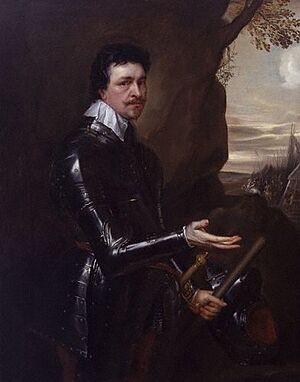
Wentworth became a privy counsellor in 1629. On January 12, 1632, he was made Lord Deputy of Ireland. He arrived in Dublin in July 1633. He had recently lost his second wife, Arabella, during childbirth. He was very sad about her death. In 1632, he married Elizabeth Rhodes, and this marriage was also happy.
As ruler of Ireland, he was very skilled. He improved the government by removing officials who weren't doing their jobs well. He managed the Irish Parliament to get the money he needed. He also helped pass useful laws. He started new trade with Spain. He also encouraged linen making and other ways to develop Ireland's resources. The Court of Castle Chamber, a special court in Ireland, became a strong part of the government.
Customs duties (taxes on goods) greatly increased under his rule. He also raised an army and stopped piracy. He tried to bring changes to the Church of Ireland. He also worked to get back Church lands that were lost during the Reformation. His strong rule helped protect the poor from the wealthy. However, he used very strict methods, which made him unpopular. His goal was to benefit England, not Ireland. For example, he stopped the cloth trade in Ireland. This was to protect England's cloth industry.
Wentworth ignored the King's promise not to give land to new colonists. This hurt Catholic landowners in Connacht. In 1635, he used an old claim to insist that juries give land to the King. Only one county, County Galway, resisted. Wentworth fined the sheriff and made the jury answer for their actions. In Ulster, he took property from city companies. This made many people angry at the government. His actions in Galway led to a conflict with the powerful Burke family.
Wentworth made many enemies in Ireland. One of the most dangerous was Richard Boyle, 1st Earl of Cork. Wentworth saw Cork's power as a threat to the King. He took Cork to court for misusing funds. He also ordered Cork to remove his first wife's tomb from St. Patrick's Cathedral, Dublin. Cork quietly worked to bring Wentworth down.
Wentworth wanted the native Irish to become more like the English. He believed they should adopt English habits, laws, and religion. He wrote that as long as Ireland was Catholic, England couldn't trust its people. However, he didn't actively persecute Catholics. He knew that since most people were Catholic, some tolerance was needed.
Under Wentworth's support, the Werburgh Street Theatre opened in Ireland. This was Ireland's first theatre. It lasted several years despite opposition from the Archbishop.
Wentworth's strict approach did lead to some improvements. It also made the King's government in Ireland stronger. He managed Parliament very well in the short term. For example, he made sure his chosen person became the Speaker of the Irish House of Commons. The Parliament of 1634/5 passed some useful laws. However, his second Parliament began to criticize his rule as soon as he left for England.
The future Duke of Ormond became Wentworth's main friend and supporter. Wentworth planned to take large amounts of land from Catholics. This was to raise money for the King and reduce the power of Irish Catholic landowners. Ormond supported this plan. But it angered Ormond's relatives. This led many of them to oppose Wentworth. In 1640, Wentworth was called back to England. Ormond was then made commander of the forces in Ireland. Wentworth's rule in Ireland ended up uniting everyone against him.
Wentworth's time in Ireland made him even more confident at court. He was not asked about English affairs until 1637. King Charles asked his opinion on getting involved in European matters. Wentworth advised Charles not to act until he had complete power at home. He believed that if the King could not raise an army, his power was incomplete. When the Scottish Covenanters rebelled, he pushed for strong action. He sent the King money for the war.
Wentworth seemed to want to settle in Ireland. In the late 1630s, he was busy building a large house. It was called Jigginstown Castle, near Naas, County Kildare. He likely wanted it to be his official home. He hoped to host the King there. The castle was never finished and fell into ruin after his death.
He also tried to build family connections in Ireland. His brother George married Anne Ruish. His sister Elizabeth married James Dillon, 3rd Earl of Roscommon. Roscommon stayed loyal to the King during the Civil War. His son, Wentworth Dillon, 4th Earl of Roscommon, was named after his uncle. He became a well-known poet.
Recall to England and Impeachment
Wentworth was called back to England in September 1639. He was needed to help with growing problems. These included the King's money troubles and war with the Scottish Covenanters. He became the King's main advisor. He didn't realize how much opposition had grown in England. He suggested calling a Parliament to support the war. He hoped a loan from the King's advisors would help the King avoid giving in to Parliament.
The King made him Earl of Strafford in January 1640. In March, he went to Ireland to hold an Irish Parliament. There, the Catholic members agreed to give money for the war against the Scottish Presbyterians. An Irish army was to be raised. When Strafford returned to England, Parliament was holding back money. He tried to get the nobles to support the King. He also convinced Charles to ask for less money.
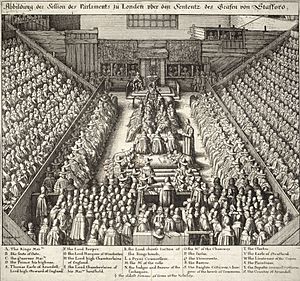
Parliament insisted on peace with the Scots. King Charles, possibly due to bad advice, went back to asking for more money. Strafford, though unwillingly, voted to close Parliament. He then advised the King to continue the war strongly. He suggested using the army from Ireland to control England. He tried to force London citizens to lend money. He also supported plans to change the value of coins. He even suggested taking gold from the Tower of London. Strafford was made commander of the English army. He also became a Knight of the Garter. But he became ill at a key moment. In September, the King gave up the fight and called another Parliament.
The Long Parliament met on November 3, 1640. King Charles immediately called Strafford to London. He promised Strafford would not be harmed. One of Parliament's first actions was to accuse Strafford of "high misdemeanours." This was about his actions in Ireland. Strafford arrived on November 9. The next day, he asked King Charles to stop his impeachment. He wanted to accuse Parliament's leaders of working against the King. But the plan was revealed. John Pym immediately started the impeachment process in the House of Lords on November 11. Strafford came to face his accusers. But he was ordered to leave and was arrested. On November 25, he was charged. On January 31, 1641, the detailed accusations were presented. They claimed Strafford tried to overturn the kingdom's basic laws. Much was made of his reported words: "You have an army in Ireland you may employ here to reduce this kingdom."
The Bill of Attainder and Execution
| Earl of Strafford's Attainder Act 1640 | |
|---|---|
| Act of Parliament | |

|
|
| Long title | An Act for the Attainder of Thomas Earl of Strafford for High Treason. |
| Citation | 16 Cha. 1. c. 38 |
| Dates | |
| Royal assent | 10 May 1641 |
| Repealed | 7 January 1662 |
| Other legislation | |
| Repealed by | Strafford Attainder Act 1662 |
|
Status: Repealed
|
|
Even if Strafford's actions were harsh, they didn't fit the definition of high treason. Many complaints came from Ireland. Strafford's enemies were happy to speak against him. But none could prove he committed treason. His words about using an army to "reduce this kingdom" were key. But they were spoken in a private meeting. Strafford argued that he was just carrying out the King's wishes. The nobles, who were his judges, were leaning in his favor. The impeachment failed on April 10, 1641.
Pym and his allies increased public pressure. They threatened members of Parliament if they didn't punish Strafford. So, Parliament changed tactics. They dropped the impeachment. Instead, they passed a bill of attainder on April 21. This bill declared him guilty without a trial. The vote was 204 to 59. Many nobles didn't like Strafford personally. But some thought simply stopping him from serving the King again was enough. Strafford's first two wives' families also tried to save him.
Strafford might have been saved if King Charles I hadn't made bad decisions. There was a secret plan to win over Parliament's leaders. There was also a plan to take the Tower of London by force and free Strafford. These plans worked against each other. When the First Army Plot was revealed on May 5, 1641, the nobles passed the attainder. Strafford's enemies were determined he should die. Nothing was left but for the King to sign the bill.
King Charles felt a strong loyalty to Strafford. He had promised Strafford that he would not die. Signing the death warrant was a difficult choice for him. But refusing Parliament could seriously threaten the monarchy. He asked his bishops for advice. They were divided. Some said he couldn't break his promise. Others said that for the good of the country, he could. Charles had promised Strafford twice that he would not suffer.
According to some accounts, Strafford wrote a letter. He released the King from his promise. He said he was willing to die to help the King and his people make peace. The King did not release this letter to Parliament. Meanwhile, angry crowds threatened the palace. They also threatened the Queen and her children. Pym revealed the King's attempts to use military force against Parliament. This put huge pressure on Charles. He gave his approval on May 10. He sadly said, "My Lord Strafford's condition is happier than mine." Some say Strafford took the news calmly. Others say he was very upset and said, "Put not your trust in princes."
Death and Aftermath


Strafford was executed two days later on Tower Hill. He received a blessing from Archbishop Laud. Laud himself was later imprisoned and executed. Strafford was executed on May 12, 1641. A very large crowd watched. The common hangman of London, Richard Brandon, carried out the execution.
After Strafford's death, Ireland had a rebellion in October 1641. This led to more disagreements between the King and Parliament. Any hope that Strafford's death would prevent further problems disappeared. Many of Strafford's enemies in Ireland found their lands and lives at risk. When King Charles I was executed eight years later, he said that God allowed his execution as punishment for letting Strafford die. In 1660, the House of Lords officially removed the record of Strafford's attainder. This meant they no longer considered it legally valid.
Personality and Appearance
Strafford made many enemies. They feared and hated him. Yet, he was also able to inspire strong friendships. At least three men who worked for him in Ireland remained loyal friends. His last letter to one friend showed a warm side not often seen. One writer described him as "Severe abroad and in business, and sweet in private conversation; retired in his friendships but very firm; a terrible judge and a strong enemy." He was a good husband and a loving father.
He was described as tall, but he stooped a lot. When he was thinking, his face looked serious. But when he spoke, he had a pleasant and cheerful look. He joked about his own "bent and ill-favoured brow." Despite his strong manner, there is no real proof that he was physically violent.
Family Life
Strafford was married three times:
- Margaret Clifford (died 1622)
- Arabella Holles (died 1631), married in 1625.
- Elizabeth Rhodes (died 1688), married in 1632.
Strafford's titles were taken away when he was declared guilty. But his only son, William, received them back from King Charles I in 1641. In 1662, Parliament reversed his father's attainder. William became the 2nd Earl of Strafford.
Besides William, Strafford and Arabella had two daughters who lived longer than him. Anne, born in 1627, married Edward Watson. Arabella, born in 1630, married Justin McCarthy. Through his daughter Anne, Strafford was an ancestor of a famous leader in the 1700s. Strafford also had a daughter, Margaret, with his third wife. The hatred many felt for Strafford did not extend to his family. His wife and children were generally treated with kindness.
Portrayals in Media
Thomas Wentworth was the subject of a play by the poet Robert Browning. It was called Strafford (1837).
He was also played by Patrick Wymark in the movie Cromwell (1970).
Images for kids


